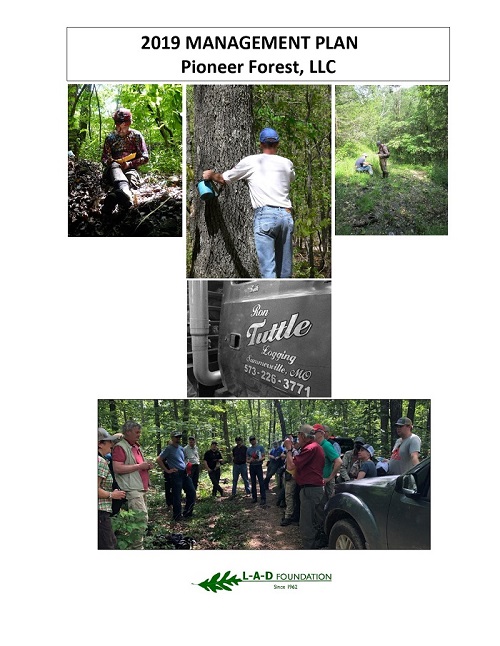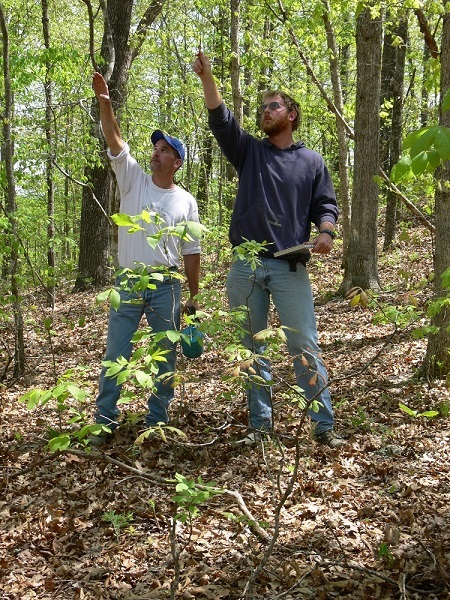L-A-D Foundation - Land Stewardship in the Missouri Ozark Highlands Since 1962
L-A-D Foundation - Land Stewardship in the Missouri Ozark Highlands Since 1962


Management on Pioneer Forest
Shown below is a Before and After overlay depicting Pioneer Forest's method of uneven-aged forest management, known as single-tree selection harvest.
The advantages of the single-tree selection method include:
- Commercial production provides income
- Canopy gaps are created in the forest canopy
- Light penetrates to the forest floor
- Fully-functioning forest remains on the landscape
- Harvest cycle is sustainable
Characteristics of the Forested Landscape on Pioneer Forest. Per acre the forest averages 51.4 trees greater than 10 inches in diameter. Of these, there are:
- 37.2 trees measuring 10-14 inches (understory trees)
- 11.9 trees measuring 14-18 inches (mostly overstory trees)
- 2.3 trees measuring 18-22+ inches (overstory)
Pioneer Forest Management Plan

In October, 2019, the L-A-D Foundation Board approved a new forest management plan for Pioneer Forest. The plan reaffirms that the forest will be managed to maintain its uneven-aged character, and details the methods that will be used to achieve this, while also protecting wildlife habitat, water quality, and soil.
Objectives for the forest include ecosystem health and resilience, improved timber quality and revenue generation, biological and ecological diversity, and a pleasing aesthetic throughout the forest even after harvest.
Pioneer Forest also seeks to provide social and economic benefits to surrounding communities, maintain primitive outdoor recreational opportunities open to the public, and protect ecological, geological, and cultural sites found on the forest.
You may read or download the entire Forest Management Plan.
Pioneer Forest Ecological Management Plan

In May, 2023, the L-A-D Foundation Board approved an ecological management plan for Pioneer Forest. This Ecological Management Plan for Pioneer Forest is the first comprehensive plan focused on defining ecological goals and objectives to maintain and promote healthy and resilient natural communities on Pioneer Forest.
This plan aims to meet the initiatives identified in the Foundation's current strategic plan including expanding staff resources to support stewardship activities, identifying and inventorying areas meriting special designation, encourage appropriate research, and expanding collaboration and leadership on key projects to advance forest conservation in the Ozarks.
The plan expands acreage under ecological management through the designation of new Priority Resource Areas and describes areas for potential future expansion. The plan establishes the Natural Features Inventory for systematically surveying the forest for natural communities and other features, which will support identification and designation of future Priority Resource Areas. These areas provide a variety of opportunities for partnership and education about natural communities in the Ozarks and as well as sharing the story of Pioneer Forest.
You may read or download the entire Ecological Management Plan.
Origins of Uneven-Aged Forest Management as Used on Pioneer Forest
The system of forest management, used on Pioneer Forest since the early 1950's, is a very old one, originating in Europe in the 1700's in mixed beech-fir forests. As practiced at that time, the system represented an accumulation of knowledge among generations of private forest owners. Europeans viewed forests as an important economic asset that, through careful management, could yield income to be used for important and periodic family needs. Harvest revenues could be used for building construction or repairs, education, weddings, or emergency. Through this experience, beginning nearly three hundred years ago, European families passed along what eventually became a recognized practice of periodically selecting trees from the forest for harvest.
In the 1800's a harvest technique known as single-tree selection was developed, as a part of the more formal description of uneven-aged forest management, by Henri Biolley in Switzerland and Adolph Gurnaud in France. From Gurnaud came the idea of the sustainability of forests through the application of single-tree selection harvests while Biolley developed the technical rules for its use as a formal management tool.
Here in the United States there has been a great deal of debate regarding uneven-aged management. It is hard to find dispassionate discussion on its merits. This is especially true for the single-tree selection technique of uneven-aged management. The European, and our own experience here in Missouri, are clear in one respect--that in certain forest types, when applied with a combination of scientific analysis and practical experience, uneven-aged management can be successfully implemented in the long term.
Click above to view or right click and "save as" to save.

Marking Single-Tree Selection Harvest in Pioneer Forest, PHOTO BY: Greg Iffrig
© 2013-2023 L-A-D FOUNDATION ♦ 725 KINGSLAND AVE., SUITE 100, ST. LOUIS, MO 63130 ♦ 314-621-0230 ♦ EMAIL: INFO@LADFOUNDATION.ORG
PIONEER FOREST ♦ PO BOX 497, SALEM, MO 65560 ♦ 573-729-4641
♦ SEE PRIVACY POLICY
This site maintained by Craig Technology Consulting • 201 E. 4th St. • Salem, Missouri 65560 • PH 573.453.2322